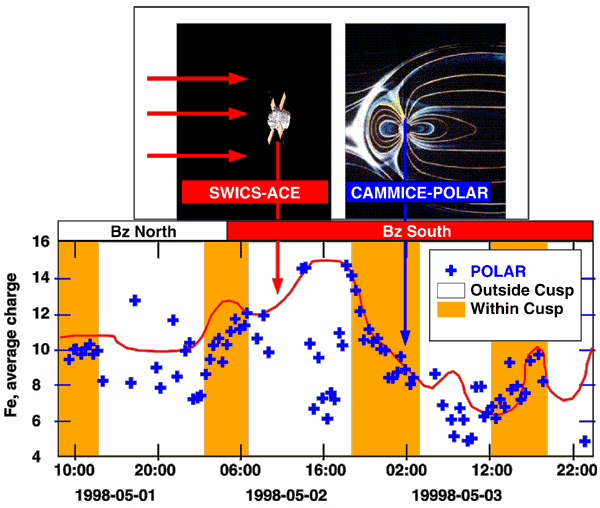
| ACE News Archives | ACE News #36 |
ACE News Archives |

The Earth and its upper atmosphere are constantly bathed in a supersonic flow of plasma from the Sun. The Earths strong magnetic field deflects much of the impacting solar wind around the planet at a distance well beyond the scale-height of the atmosphere. However, the solar wind and the terrestrial plasma can be strongly coupled by magnetic fields, resulting in a transport of energy, momentum, and mass from the solar wind into the magnetosphere. This interaction can be quite dramatic and may lead to magnetic storms and substorms.
A very important unknown in this complicated process is the entry into and transport of solar wind plasma through the magnetosphere. It is generally very difficult to predict the actual entry location and properties of the transport for a given set of solar wind conditions. Using ACE-SWICS and Polar-CAMMICE data, we have been able to explore the entry and transport of solar matter during a CME event in May 1998.
The ionic charge composition of Fe in the May 2, 1998, CME was highly variable (ACE News #16) allowing it to be used (like dye in a flow of water) to trace matter from the solar wind (as seen by ACE at L1) into the magnetosphere (as seen by Polar in its 9 x 2 RE elliptical orbit, inclined at 86 degrees). Plotted in the figure above is the average charge of Fe measured by both SWICS-ACE (red line) and Polar-CAMMICE (+). Not surprisingly, the penetrated solar wind can be seen in energized form in the cusp, where more field-aligned transport is possible. It also appears that the delay time between detection on ACE and that on Polar depends strongly on the direction of the interplanetary magnetic field. Whenever the field is predominantly southward, the access is almost immediate; when the field direction is north, a more delayed transport is observed. When Polar is outside the cusp, the observed charge states generally appear to be unrelated to those in the solar wind.
Detailed comparison of the two datasets has the potential of greatly constraining models of the direct transport of solar wind into the magnetosphere.
Contributed by Thomas Zurbuchen of the University of Michigan and Chris Perry of Rutherford Appleton Labs, UK.
See The SWICS Home Page for more information on ACE SWICS.
See The CCR Home Page for more information on POLAR-CAMMICE
Last modified September 27, 1999.
Andrew Davis